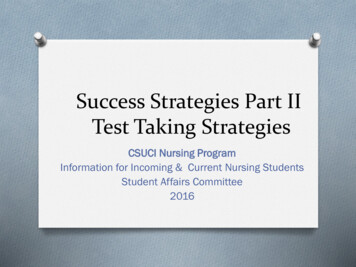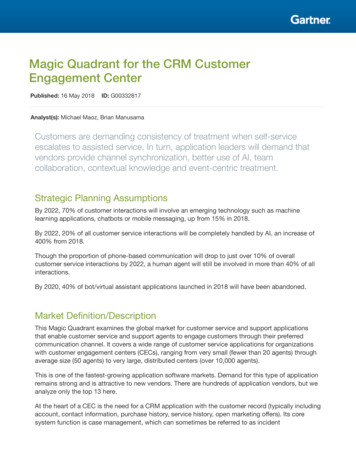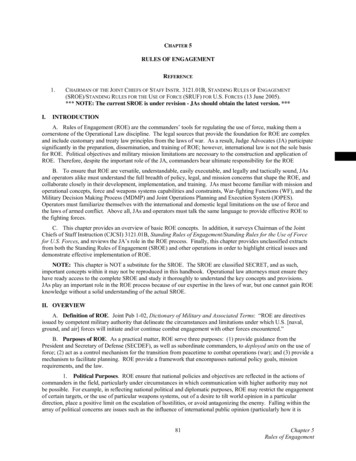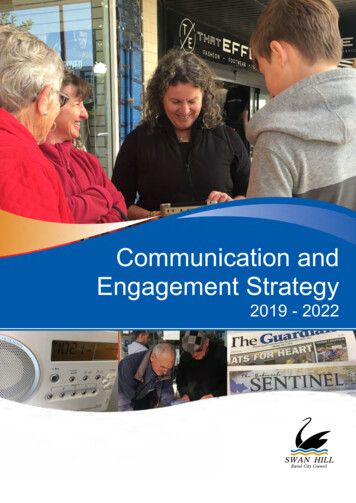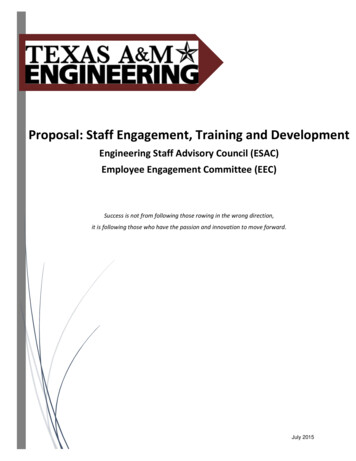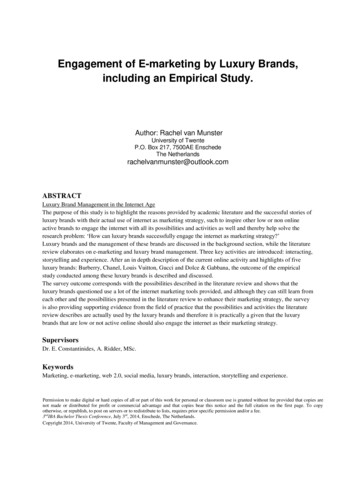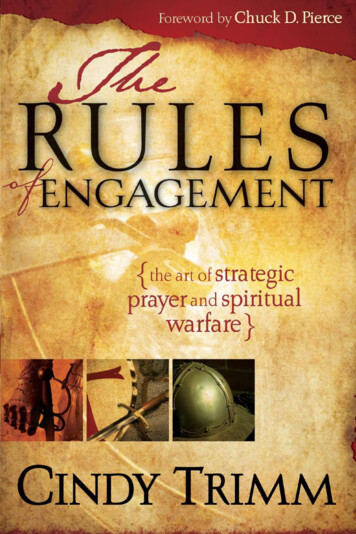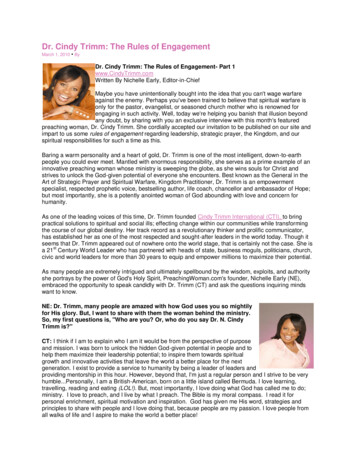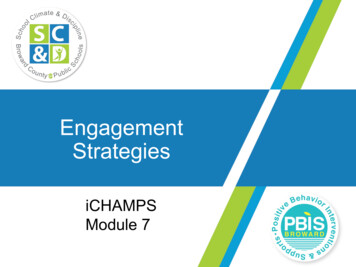
Transcription
EngagementStrategiesiCHAMPSModule 7
Engagement Strategies Provide instructional structure that develops responsible, motivated,and highly engaged students Provide learning experiences that challenge, motivate, and activelyinvolve the learner Encourage adaptability, flexibility, resourcefulness, and creativity Encourage students to become deeply involved in their workPositive Behavior Interventions & Supports
ObjectivesAfter this presentation, you will Understand the concept of student engagementLearn how to increase student engagement through:o Marzano’s 5 Engagement Conceptso Social Emotional Learning (SEL)o Universal Design for Learning (UDL)o Opportunities to Respond (OTRs)Positive Behavior Interventions & Supports
What is Student Engagement?Educational strategies andteaching techniques thataddress the developmental,intellectual, emotional,behavioral, physical, andsocial factors that enhanceslearning for students.The Glossary of Educational Reformdefines student engagement as: thedegree of attention, curiosity,interest, optimism, and passionthat students show when learning orbeing taught. learning improveswhen students are inquisitive,interested, or inspiredSomething WE do Creates this student outcomePositive Behavior Interventions & Supports
Levels of EngagementEngagedI’m super excited to dive in and learn! I willstick with it even when it gets challengingStrategicI’ll will be interested and follow along butwon’t internalize and won’t do more than Ihave toRetreatedI’ll hide in the back and try to avoidparticipation because it sounds boring or Idon’t know how to do it, nor do I careRebellionI’m so uncomfortable or so uninterested thatI’ll likely get distracted, will make jokes orrebelPositive Behavior Interventions & Supports
Engagement doesn’t just lectiondemonstrationKnowledgeApplication“hooking students in”KnowledgeAcquisitionPractice &Processmaking senseexploring &masteryPositive Behavior Interventions & Supports
Engagement OutcomesStudent who are engaged Develop theirown ideas!Find their ownmistakes!Take time tothink!Positive Behavior Interventions & Supports
Research shows Robert Marzano’s research (2007) shows that students in highlyengaging classrooms outperform their peers by an average of almost30 percentile points.“Misbehaviors . were so rare in the highly motivating, engagingclassrooms that we leave this study still not certain what theconsequential policies were in any of the highly engagingclassrooms.This contrasts with classrooms defined as “low engaging” where ittook “at least 10-15 minutes to begin class, and which was oftendelayed further by behavioral disturbances”.Positive Behavior Interventions & Supports
It’s in your evaluation StudentStudentEngagementEngagementPositive Behavior Interventions & Supports
Pinch CardsUsing research-based strategies will increase studentengagement and student achievement by an average ofpercent?A. 30-40%B. 20-30%C. 10-15%D. 45-60%Positive Behavior Interventions & Supports
Making the connection Working together to Marzano’s 5StrategiesSocial EmotionalLearning (SEL)Universal Designfor Learning (UDL)Opportunities toRespond (OTRs)1. High EnergyClassroomSelf-managementEngagementWhite boards2. MissingInformationSelf awarenessBall passDecision makingRepresentationAction & Expression3. Mild Controversy& Competition4. Mild Pressure5. Self SystemPinch cardsRelationship skillsTrue/false cardsSocial awarenessShare PairPick SticksFinger scalesEtc . .optimize engagementandInterventionslearning & SupportsPositive Behavior
M5Marzano’s 5 ConceptsFive areas to consider toincrease student engagement:1. High energy2. Missing information3. Self- system4. Mild pressure5. Mild controversy & competitionPositive Behavior Interventions & Supports
Worksheet PracticeComplete A. Marzano’s 5 Engagement Concepts with example(s)(as we go through each one)Positive Behavior Interventions & Supports
M51. High EnergyThe same part of the brain that processes movement also processes learning.When planning lessons, find ways for students to engage in movement.Positive Behavior Interventions & Supports
M5High Energy examples Teacher Demonstrates intensity and enthusiasm for content Frequent checks for understanding:o Response cards (white boards)o Hand signals (finger scales, thumbs up, clapping) Stand up and stretch Physical representation Give one, get one and Share Pair Vote with your feet Cooperative jigsaw Gallery walk and poster session Beat the timerPositive Behavior Interventions & Supports
M52. Missing InformationAcademically focused puzzles and games wet the “mental appetite”and provide an element of anticipation.Positive Behavior Interventions & Supports
M5Missing Information examples Crossword puzzles / word search puzzles Hangman Visual puzzles Jeopardy Content games:i.e. Math:What numbers are missing from this sequence?79, 75, , 67, 63, , Free online games:i.e. PBS Kids GamesNational Geographic GamesPositive Behavior Interventions & Supports
M53. Mild Controversy & CompetitionWhen competition is built-in (but not too strong), it can enhance learningby adding excitement and fun into classroom activities. Students enjoy problem solving withand against peers Structured debates and groupcompetitions enhance studentachievement Inconsequential competition such as“Jeopardy”, All students must be involved andparticipate All students must have theopportunity to win and be successfulPositive Behavior Interventions & Supports
M5Controversy & Competition examples Debates – individual and small group O-P-V (students defends opposite point of viewfrom own) Project competition Seminar groups (exploring “highly charged”material) Trivia (content) competition Compare and contrast activities (such as Venndiagraming) Educational game competitions Behavior competition “Expert” opinions (researching and debatingmerits of expert ideas) TournamentsPositive Behavior Interventions & Supports
M54. Self-SystemThe self-system controls what we decide to attend to. Everything wefind personally interesting and valuable.If the task is judged important (1),if the possibility of success is high (2),and a positive effect (3) is associated with the task,the individual is motivated to engage in the task.Marzano, Pickering, and Pollack, 2001(1) Do I need to do this?(2) Can I do this?If yes,(3) Do I like doing this?Do I benefit from doing this?LearningprocessENGAGED!Positive Behavior Interventions & Supports
M5Self-System examples Interest surveys Student learning profilesi.e. Under what conditions do you learn best?Do you like to work alone or with others? Self-reflection forms Explicit connections to personal lives Talent show, music, spoken word, etc. Presenting unusual information Guest speakers and “first-hand” consultants Provide opportunities to talk about themselvesPositive Behavior Interventions & Supports
M55. Mild PressureStudents are smart; they look for patterns in our behavior. Keep themguessing and attentive. Students will raise their level of attention if there is amoderate chance they will be called on. Mild pressure forces attention on tothe source of the pressure When students have even a mildchance of being called upon,“anticipatory attention” sharpens Increasing the rate of studentresponse, increases academicachievement Wait time focuses attention andincreases student thoughtfulnessPositive Behavior Interventions & Supports
M5Mild Pressure examples Pick Sticks Choral response techniques Increased wait time Post question: minimum of 3 seconds with eye contact Within-student answer: minimum of 3 seconds for processing Post student answer: minimum of 3 seconds for other students toprocess Seeking more comprehensive answers from studentsPositive Behavior Interventions & Supports
M5Pinch CardsWhen students are given a choice to debate something theybelieve in with a student who has a different point of view, theteacher is utilizing which two of Marzano’s engagementconcepts.A. High Energy and Mild Controversy and CompetitionB. Mild Controversy & Competition and the Self-SystemC. Mild Pressure and Missing InformationD. The Self-System and High EnergyPositive Behavior Interventions & Supports
SELSocial Emotional Learning5 Social Emotional Learning (SEL) CompetenciesPositive Behavior Interventions & Supports
SELSocial Emotional tionPart of theClimate andCulturePositive Behavior Interventions & Supports
SELSEL Examples LEAPS Skillstreaming Second Step Cloud 9 SEL Curriculum Anti Bullying Programs Classroom Meetings Character Education CASEL Programs PAX Good Behavior GamePositive Behavior Interventions & Supports
SELPinch cardsWhich one is NOT a SEL strategy?A. Character EducationB. LEAPsC. CHAMPsD. Classroom MeetingsPositive Behavior Interventions & Supports
SELWorksheet PracticeComplete B. List 3 different SEL programsPositive Behavior Interventions & Supports
UDL What is Universal Design for Learning?UDL is a “ framework for guiding educational practicethat provides flexibility in the ways information ispresented, in the ways students respond or demonstrateknowledge and skills, and in the ways students areengaged (National Center on Universal Design forLearning, 2011).”Basically, UDL is allowing students to have multiplemeans of engagement, expression and representationPositive Behavior Interventions & Supports
UDLPositive Behavior Interventions & Supports
UDL Three principles of UDLPositive Behavior Interventions & Supports
UDL Worksheet PracticeComplete: C. Provide 2 examples for each UDL Principle(as we go through each of them)Positive Behavior Interventions & Supports
UDL 1. Multiple Means of EngagementTap into interests & choice, offer challenges, and increasemotivation. The “WHY” of learning.Chunking &DiscussionGuided learningManipulatives &Hands-onCooperative workProject based learningPositive Behavior Interventions & Supports
UDL 2. Multiple Means of RepresentationProvide diverse learners options for acquiring information andknowledge in a variety of ways. The “WHAT” of oActivitiesAudiobooksBehavior Interventions & SupportsPositive
UDL 3: Multiple Means of Action & ExpressionProvide learners options for demonstrating what they know.The “HOW” of learning.Drama ResponseVerbal ResponseWritten response(movement)MultimediaArtistic Response(visual)Positive Behavior Interventions & Supports
UDL Pinch CardsThe three principles of UDL are:A.B.C.D.Engagement, Mild Pressure and High EnergyEngagement, Representation and Action & ExpressionThe Self-System, Representation and CompetitionOTRs, Choice and EngagementPositive Behavior Interventions & Supports
OTROpportunities to Respond (OTRs)I don’t knowPositive Behavior Interventions & Supports
OTR Types of OTRs White Boards Pick Sticks Pinch CardsFinger Scales Ball Pass Pass / LifelineChoral ResponseCompletion SignalShare Pair Raise Hand True/False Cards Thumbs UpPositive Behavior Interventions & Supports
OTRVideo for all grade levelsPositive Behavior Interventions & Supports
OTRBall tossHow many OTRs are there?Limited only to the teacher’s imagination!Positive Behavior Interventions & Supports
OTRBall tossHow many times an hour should you implement an OTR?10 to 40 per hour!Positive Behavior Interventions & Supports
OTRWorksheet PracticeComplete D. Identify 3 OTRs you will implement inyour classroom. Indicate how and when you woulduse them.Positive Behavior Interventions & Supports
Remember e Behavior Interventions & Supports
Questions?For more information,Call:The School Climate & Discipline Department(formerly Diversity, Prevention & Intervention Dept.)Lauderdale Manors Resource Center(754) 321-1655Check out our PBIS Sharepoint wardschools.comPositive Behavior Interventions & Supports
Engagement Strategies Provide instructional structure that develops responsible, motivated, and highly engaged students Provide learning experiences that challenge, motivate, and actively involve the learner Encourage adaptability, flexibility, resourcefulness, and creativity E


